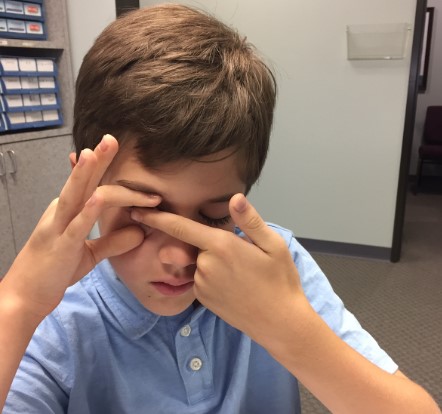How ortho-k works
Gas Permeable lenses for ortho-k are applied at bedtime and worn overnight. While you sleep, the lenses gently reshape the front surface of your eye (the cornea) to correct your vision, so you can see clearly without glasses or contact lenses when you’re awake. The effect is temporary – generally enough to get you through a day or two – so you must wear the reshaping lenses each night to maintain good vision during the day.

Who is a candidate for ortho-k?
Ortho-k is very suitable for nearsighted people who are not appropriate candidates for vision correction surgery, such as children. Individuals of all ages with healthy eyes can try ortho-k, namely because it can be discontinued at any point without permanent effects to the eyes.
People who require vision correction and engage regularly in sports or work in extremely dusty, dirty environments will also appreciate the convenience of ortho-k.

What results can you expect from ortho-k?
The goal for ortho-k is to correct your vision to 20/20 without eyeglasses or contact lenses during the day. In FDA trials of both CRT and VST lenses, more than 65% of patients were able to achieve 20/20 visual acuity after wearing the reshaping lenses overnight. More than 90% were able to see 20/40 or better (the legal vision requirement for driving without glasses in most states).
Success rates for ortho-k tend to be higher for mild prescriptions. Call our office to find out if your prescription is within the range that can be successfully treated with ortho-k.

How long does ortho-k take?
Though you may see some improvement in your vision after a day or two of overnight ortho-k, it can take several weeks for the full effect to be apparent. During this time, your vision will not be as clear as it was with glasses or contacts, and you are likely to notice some glare and halos around lights. It's possible you may need a temporary pair of eyeglasses for certain tasks, like driving at night, until your vision is fully corrected by the ortho-k lenses.

Cost of orthokeratology
Professional fitting for ortho-k requires a series of visits to your eye doctor. A number of pairs of contact lenses are also generally needed. GP lenses that are special for ortho-k are more costly than standard contacts. In sum, the fees for ortho-k add up to a higher total than regular contact lenses.

Is ortho-k comfortable?
Some people have comfort issues when attempting to wear gas permeable contact lenses during the day. But since ortho-k GP lenses are worn during sleep, comfort and lens awareness are generally not a problem.

Can I have LASIK after ortho-k?
Yes, it's possible to have LASIK surgery after orthokeratology. But because ortho-k lenses reshape your cornea, you must stop wearing the lenses for a period of time (usually several months) so your eyes can return to their original shape and stabilize. Be sure to tell your LASIK surgeon that you've worn ortho-k lenses, so they can advise you how long you should wait before having the surgery.

Can I try Orthokeratology instead of Lasik?
Both are solutions to wearing glasses or contacts which is especially great for those playing sports or participating in activities where wearing glasses or contact lenses can be bothersome. Lasik is certainly the easier solution and a quicker fix but many patients are a bit scared to have surgery and it is expensive.
Ortho-K, in contrast, is often half the cost of Lasik. Granted, Ortho-K does require putting in special lenses every night. It is thus important to give us a visit so we can discuss the pros and cons of each option.


At only age 9, this young man is already at -3.00 in both eyes.
As a member of his band, he has to handle marching along with other band members and playing his instrument with perfect timing. Practicing each song & reading sheet music requires healthy vision and clarity.
Through his new ortho-k lenses, he’ll enjoy perfect daytime vision throughout the day.
Main Applications

Myopia Control
Studies show ortho-k decreases both the rate of progression and the final amount of myopia (nearsightedness) in kids.

What Is Myopia Control?
In recent years, a number of advanced methods have been developed to control myopia. Unlike glasses or regular contact lenses, the goal of myopia control is to slow or even halt the progression of myopia entirely.

Freedom from glasses and contact lenses
People working in dirty or dusty environments also appreciate the convenience from ortho-k.

What Causes Myopia?
Myopia is very often progressive. This means that the distance vision gets worse and worse, meaning your child constantly needs an updated and stronger prescription and new glasses or contacts.
